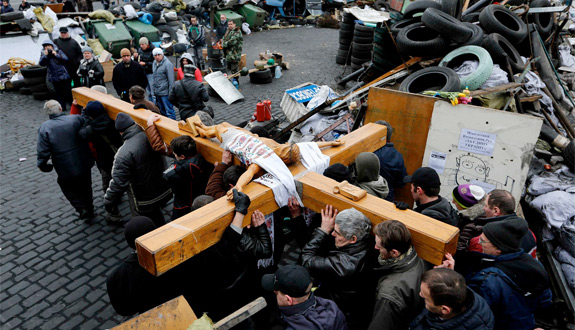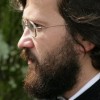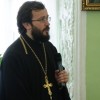The conflict between the state and the society in Ukraine has led to a significant, and positive, shift in perspective among Orthodox, Catholics, and Protestants.

Mourners carry a large wooden crucifix past a barricade during a memorial procession in Independence Square in Kiev, Ukraine, Feb. 25. Dozens of protesters have been killed since November. (CNS photo/Yannis Behrakisi, Reuters)
The religious map of Ukraine on the eve of the protests that began in November 2013 looked like a mosaic of military camps. The troops did not conduct active maneuvers nor openly attack each other. They just stayed in their tranches, while their generals occasionally met on the neutral ground to imitate negotiations on truce, which none of them really wanted. The situation changed, however, when the civil protests began in November 2013 at the central square of Kiev, the Maidan of Independence. The civil awakening urged the Ukrainian churches to reconsider their relationship to each other. This followed the reconsideration of their relationship with the Ukrainian state and the society. The common fight for restoration of social justice and later on against the aggression of Russia provide the Ukrainian Churches a chance for reconciliation.
Statistics
Ukraine is religiously diverse. No one Church has a monopoly. The largest is the Ukrainian Orthodox Church (UOC) in communion with the Patriarchate of Moscow. According to the official statistics1, in January 2013 it had 12,485 registered communities. This is the only Ukrainian church recognised by the fellowship of the Orthodox Churches worldwide. For 22 years the Primate of this Church was Metropolitan of Kiev Volodymyr Sabodan. In recent months, however, his health condition has dramatically deteriorated. For this reason on February 24, the Synod of this Church elected as Locum Tenens of the Kievan See Metropolitan Onufry.
The second largest Church is the Patriarchate of Kiev (UOC KP), which was founded in 1992 by the former exarch of Ukraine Filaret Denisenko, who was anathematised for this by the Patriarchate of Moscow. This Church, according to the same statistics, counted 4,536 registered communities in the beginning of 2013.
The third is the Ukrainian Autocephalous Orthodox Church (UAOC) with 1,205 registered communities. It originates from the Autocephalous movement that started in 1918, then moved into the emigration, mostly Canada and the US, and after Ukraine became independent, returned to its motherland as a UAOC.
There is also a Ukrainian Greek-Catholic Church (UGCC), a Catholic Church sui iuris, which follows the eastern rite. In January 2013, this Church counted 3,734 registered communities, mostly in the western Ukrainian region of Galicia. It nevertheless developed a distinct social teaching and has a powerful voice recognised throughout the whole country. The rest of the Ukrainian Churches, including the Roman Catholic Church with 919 communities, act publicly mostly through the All-Ukrainian Council of the Churches and Religious Organisations. This Council is the most effective platform of cooperation between different religious groups in Ukraine, including Jewish and Muslim communities.
Civil awakening
All major Ukrainian Churches, including the Greek-Catholic Church, belong to the eastern Christian tradition. According to this tradition, the Church gives priority to relations with the state, and not so much with the society. The Maidan, however, urged the Ukrainian Churches to begin realising that the unilateral relationship of the Church with the state is insufficient. There exists a society, which has its own interests that can be very different from the state.
In Ukraine, the society opposed the kleptocratic and violent state and articulated its own agenda. Under the pressure of the conflict between the state and the society in Ukraine, the Churches realised that society is distinct from the state and equally important for them, if not more important. They had to choose between the two, and all of them eventually chose the side of the society. Some of them earlier, like the Greek Catholic Church, and some later, like the Ukrainian Orthodox Church in unity with the Moscow Patriarchate.
The Ukrainian Churches “discovered” for themselves the society with its distinct agenda owing to the Maidan. Why did the Maidan become a power that made the Ukrainian Churches change their orientation from the state to the society? The Maidan was a community, which can be interpreted as a classic instance of the civil society. This community understood itself on the basis of shared values, including dignity, honesty, non-violence, solidarity, and readiness for self-sacrifice. Civil society in the form demonstrated by the Maidan can hardly be found even in the modern Europe, where for the most part people nowadays are united on the basis of common interests, but not common values.
The Ukrainians saw how the European politicians betrayed the European Maidan, but the Ukrainians did not betray the values that Europe, historically, stood for. The Churches realised how close these values are to the values of Christianity, including altruism, readiness for self-sacrifice, and solidarity. The Maidan pushed the Churches to rise above the status quo that dominated their relationship with the state for years, and to take the side of the society in its struggle with the violent regime.
The common effort of the Ukrainian Churches in addressing the issues of social justice and human dignity raised by the Maidan gave a clue to the solution of another problem that has been plaguing the Churches in Ukraine since the country’s independence: the ecclesial schisms. The Orthodox Churches in Ukraine are divided not for ecclesial or theological reasons, but for social and political ones. The social divide in the Ukrainian society is the real reason of the schisms. By helping bridging this divide, the Churches help themselves; they thus pave a way to reconciliation and the overcoming of schism.
Condemnation of intervention
Even more the divided Churches became united in dealing with the challenges, which Ukraine faced immediately after the victory of the Maidan, of separatism in the east and south of the country, and Russian military aggression. They’ve began acting—not with separate efforts, as often happened during the protests at the Maidan—but with more unity. They chose the platform of the All-Ukrainian Council of the Churches and Religious Organisations to voice their concerns. First, on February 22, 2014—the same day that President Yanukovych was effectively ousted—the members of the Council, presided over by the representative of the OUC Metropolitan Antony, signed a statement concerning the threat of separatism.2 On February 25, the members of the Council met with the speaker of the Ukrainian Parliament and the acting President of the country, Olexandr Turchynov, who is a Baptist pastor. After this meeting, the members of the Council issued a statement, which confirmed legitimacy of the new government in Kiev.3
The voice of the Churches became particularly strong and unified in their condemnation of the Russian aggression against Ukraine. A relevant statement was promulgated on March 2, the day after the Upper Chamber of the Russian Parliament gave its permission to President Putin for deployment of the Russian troops in Ukraine:
On March 1, 2014 the Russian Federation Soviet of the Federation of the Federal Sobranie on request of the President of Russia has given its permission to employ Russian troops in Ukraine. The military engagement of another country on the territory of Ukraine is a threat not only for our country but also for peace and stability on the European continent in general.
We call the authorities of Russia to give up the military or any other interference into internal affairs of Ukraine that are not provided by the international law and bilateral agreements. The Russian authorities ought to realize their responsibility before God and mankind for possible irrecoverable consequences of the military conflict on the Ukrainian land.
The Ukrainian people have friendly, fraternal feelings toward the Russian people. Citizens of Ukraine do not wish to enflame hostility. We want to continue to build fraternal relations with Russia as a sovereign, independent country.
Once again we testify to the recognition of the legitimacy of the state authorities formed by the Verkhovna Rada (Parliament) of Ukraine and the officials appointed by the acting President Oleksandr Turchynov and the Government of Ukraine.
We appeal to the international community with the request to do all the things possible to keep peace in Ukraine and keep the territorial integrity, sovereignty and inviolability of the borders of the Ukrainian state. Undermining of peace and stability in Ukraine threatens to ruin all the modern system of the world safety. Therefore all the measures should be used to keep Ukraine from war resulting from the employment of the foreign troops.
Churches and religious communities of Ukraine are with the Ukrainian nation. We call all to more fervent prayers for our Motherland.4
The Ukrainian Orthodox Church in connection with the Moscow Patriarchate has special ties with the Russian ecclesial and political leadership. Therefore, it has more possibilities than the rest of the Ukrainian Churches to influence Russia. This Church was hesitant in supporting the protests against the regime of Yanukovych, and until that regime fell it tried to remain neutral.
After the fall of the Yanukovych regime, however, this Church became more active in supporting the aspirations of the society. It offered its mediation with Russia beyond the statement of the All-Ukrainian Council of the Churches and Religious Organisations. The Locum Tenens of the Church, Metropolitan Onufry sent a letter to the Patriarch of Moscow Kirill5 and President of Russia Vladimir Putin calling on them to avoid a military conflict with Ukraine and to preserve the territorial integrity of the country. In his letter to President Putin, Metropolitan Onufry, in particular, said:
Today our suffering Motherland, which we all equally love and wish it peace and prosperity, faced one of the biggest challenges in its history. After a long internal crisis and loss of life, a new serious cause for concern became the fact that the Federation Council of the Federal Assembly of the Russian Federation empowered you with the right to use the Armed Forces of Russia in Ukraine. Very little separates us from slipping into the abyss. It will take more than a decade to get out of there.
During the visit of His Holiness Patriarch Kirill to Crimea, he uttered wise words that the two fleets of the fraternal peoples should never look at each other through the sights of guns.
Lord judged you to lead a great country. Knowing you as an Orthodox Christian, I ask you: stop human suffering, prevent division of the Ukrainian state and of our holy Church.
The official rhetoric today is far from being able to calm down the people of God, both living on the peninsula and in all other parts of Ukraine. A careless word can lead to unpredictable consequences, and God forbid turn into a disaster. I urge you as a guardian of the laws of the great country to stand in the way of division, to prevent bloodshed and fratricide of the peoples who came from the same baptismal font of Dnieper.6
The Patriarch Kirill answered the appeal of Metropolitan Onufry on the same day. He in particular promised to “do everything possible to convince all those in whose hands is the power, that they should not allow the death of innocent people.”7
An answer has not yet been received from Mr. Putin as of this writing.
Dialogue
The synod of the Ukrainian Orthodox Church that was convened immediately after the change of the government and which elected a Locum Tenens, made another important decision: it set up a commission on the dialogue with the Patriarchate of Kiev. This was a bold step, given that previously any attempt to proceed to an official dialogue was blocked.
This is an indication that the religious map of Ukraine can change. The Churches will not be looking at each other from the trenches through the sight of guns. Now that they find themselves in the same trenches fighting the occupation of Ukraine, they feel that they have become brothers in arms. Hopefully, one day they will find that they are also brothers in Christ. Today this day has become close as never before.
Endnotes:
1 The data provided by the Department of the religious and national affairs of the Ministry of Culture of Ukraine. Available on http://risu.org.ua/ua/index/resourses/statistics/ukr2013/51768/ [accessed February 2, 2014].
2 Published on the website of the All-Ukrainian Council of the Churches and Religious Organizations: http://vrciro.org.ua/index.php?option=com_content&task=view&id=218&Itemid=1 [accessed February 3, 2014].
3 Published on the website of the All-Ukrainian Council of the Churches and Religious Organizations: http://vrciro.org.ua/index.php?option=com_content&task=view&id=219&Itemid=1 [accessed February 3, 2014].
4 Published on the website of the All-Ukrainian Council of the Churches and Religious Organizations: http://vrciro.org.ua/index.php?option=com_content&task=view&id=220&Itemid=1 English translation by the Institute of Religious Freedom in Ukraine: http://www.irf.in.ua/eng/index.php?option=com_content&view=article&id=387%3A1&catid=34%3Aua&Itemid=61 [accessed February 2, 2014].
5 Published in the website of the Ukrainian Orthodox Church: http://news.church.ua/2014/03/01/misceblyustitel-kijivskoji-mitropolichoji-kafedri-nadislav-list-svyatishomu-patriarxu-kirilu/ [accessed February 3, 2014].
6 Published in the website of the Ukrainian Orthodox Church: http://news.church.ua/2014/03/02/misceblyustitel-kijivskoji-mitropolichoji-kafedri-nadislav-list-prezidentu-rosijskoji-federaciji-v-v-putinu/ [accessed February 3, 2014].
7 Published in the website of the Moscow Patriarchate: http://www.patriarchia.ru/db/text/3588256.html [accessed February 3, 2014].
Source: The Catholic Work Report















